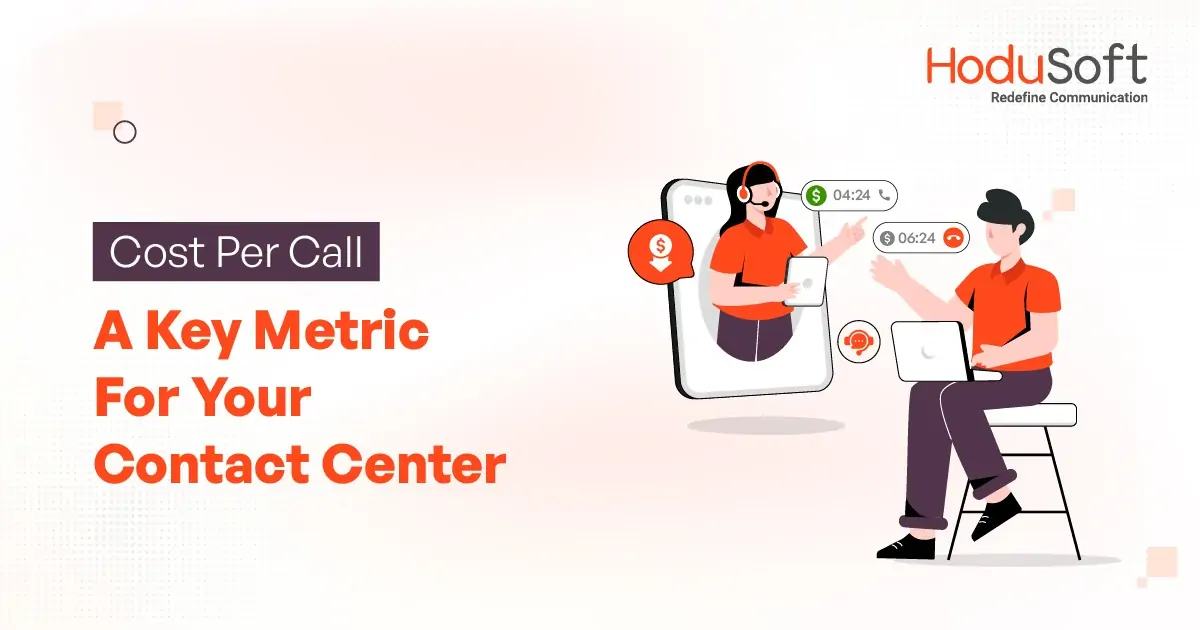Cost Per Call : A Key Metric for Your Contact Center
Have you ever wondered how much money you spend to handle a single call? If you’ve mulled over the question, then you must be aware of the concept known as ‘cost per call.’
Cost per call is one of the most important metrics for contact centers. As an owner or a manager of a contact center, you must calculate your cost per call to make sure that you have no inefficiencies in your operations.
This blog post discusses cost per call in detail as well as the importance of cost per call and the ways to reduce cost per call.
What is the cost per call?
As the name indicates, cost per call is the cost incurred to handle a single call. It’s a metric that’s used to determine the budget allocation for each call. It calculates the overall efficiency as well as the agent ratio to calls. .
Factors that affect the cost per call
Starting from a contact center’s fixed costs to variable costs, many factors affect its cost per call. Here are some factors that affect the cost per call:
1. Agent wages and salaries
Agents’ salaries and wages have a huge impact on cost per call as they are the most substantial costs for contact centers. When the salaries and wages are high, then the cost per call will also be high. Lower wages can reduce the cost per call.
But this is an area contact center should not compromise to reduce cost per rate. High-quality agents are worth their salt. If you focus constantly on lowering salaries and wages, then you are more likely to get sub-par performance.
2. Technology costs
Technology is the lifeblood of every business, especially contact centers. Modern contact centers can’t operate without a wide range of technology tools. So technology costs are among the major costs in contact centers.
The technology costs can include contact center software, customer relationship management (CRM) systems, business phone systems, call routing software, and more.
3. Overhead costs
Cost per call is massively influenced by several overhead expenses such as office rent, utilities, and other operational costs. These costs are mainly fixed costs and they remain the same irrespective of the number of calls handled. Contact centers must distribute their entire overhead costs across all calls to calculate the accurate cost per call.
4. Training costs
Speaking of agent training, contact centers need to train their agents at regular intervals to get desired performance from them. When agents are provided initial and ongoing training, they perform their tasks optimally. Training costs include trainers’ costs as well as costs incurred to create training materials, resources, stationery, etc.
5. Call volume and agents’ productivity
Call volume also affects the cost per call. Higher call volumes increase the cost per call as they require more resources and agents to handle the workload.
Contact center agents’ productivity and efficiency can impact the cost per call. Agents who effectively and quickly handle more calls in a specific time reduce the cost per call.
6. Call duration
Cost per call has a huge bearing on the average call duration. The longer are the calls, the more time and resources they consume. Contact centers can reduce their call duration by leveraging automated systems and agent training.
7. Outsourcing costs
In case a contact center outsources its operations to any other service provider, it would have to bear additional costs such as contract fees, service level agreements, and other miscellaneous costs.
How to calculate the cost per call in a contact center?
Calculating the cost per call in a contact center involves considering various factors such as agent salaries, overhead costs, and call volume. Here’s a step-by-step guide on how to calculate the cost per call:
Calculate the total costs:
Add all the costs that your contact center incurs in a specific period (for a month or a day).
Determine the call volume:
Determine the total number of calls handled by the contact center during the period.
Calculate the cost per call:
Divide the total costs by the call volume. The result will be the cost per call.
Formula:
Cost per call = total costs/call volume
Example:
Let’s imagine a scenario where a contact center spends $5,000 in overheads (rent, utilities, and other miscellaneous operational costs), $5,000 in agents’ salaries, and $2,000 in technology costs in a month. During that month, the contact center handled 3,000 calls.
Total costs = $5,000 + $5,000 + $2,000 = $12,000
Cost per call = $12,000 (total costs) / 3,000 (call volume) = $4 per call
In this example, the cost per call is $4.
Now, we can do the same to calculate the cost per call taking daily costs. Let’s suppose a contact center spends $150 in daily overheads, $200 in agents’ wages, and $50 in technology costs. On an average day, the contact center handles 100 calls.
Total costs = $150 + $200 + $50 = $400
Cost per call = $400/100 = $4 per call
In this example, the cost per call is also $4.
Note: Please do note that the calculation provides an average cost per call. It, however, doesn’t consider other key factors such as call type complexity, call duration, or additional revenue generated from the calls.
What is a good cost per call?
As per industry standards, an acceptable cost per call could range anywhere from $2.70 to $5.60. However, the cost per call varies from one industry to the other.
In both of our examples, the cost per call of $4 falls under the industry standard range.
In some industries (where customer communication is supposed to be easy and cost-effective) a cost per call of $5-$6 could be regarded as high. But it could be considered reasonable (or even low) in industries where customer communication is not that easy.
In some cases, cost per call can account for almost 50 percent of the total cost of fulfilling an order.
Importance of cost per call
By calculating the cost per call, contact centers not only know how much money they spend on each call but also improve a lot of things. The cost per call is a useful metric for several reasons:
1. Cost management
Determining the cost per call can enable you to manage your costs associated with customer service and contact center operations. For example, your cost per call is $5 and your industry standard is less than $4.
That will give you an indicator that your average call cost is 20 percent higher than your average competitor. This will enable you to find ways through which you can bring down your cost per call and be competitive in your industry. It’ll also help you in resource allocation, budgeting, and finding areas for reducing costs.
2. Performance evaluation
Calculating cost per call can help you in determining the efficiency and effectiveness of your contact center operations.
By comparing the cost per call against industry benchmarks, you can measure your performance and identify areas for improvement.
3. Process optimization
Determining cost per call helps in the identification of bottlenecks and inefficiencies in call center processes.
By calculating cost per call, contact centers can streamline workflows, reduce call durations, optimize resource allocation, and optimize processes.
4. Decision making
Calculating the cost per call metric can provide you with valuable insights that will help you while making data-driven and strategic decisions.
Taking your cost per call into account, you can focus on the expansion of your contact center operations, adoption of new technologies, or any other areas.
5. To assess ROI
Return on investment (ROI) is the foundation of every business decision. If a contact center doesn’t get the right return on its investments, then it cannot sustain its operations in the long run.
Cost per call enables a contact center to determine its ROI. After calculating the cost per call and initiating changes, contact centers can compare their costs before and after implementing changes and can know if they’re getting the desired outcome.
6. Resource planning
Resource planning is one of the major benefits of cost per call. When contact centers ascertain their cost per call, they can better plan workforce management, staffing decisions, schedules, and agent training requirements. That would enable contact centers to serve customers effectively.
7. Performance comparison
Let’s be honest; when a contact center manages multiple teams, campaigns, and departments, then one of them will report the best cost per call compared to the rest.
Determining the cost per call of the best team or campaign can enable contact centers to recognize the best practices of the best-performing team and identify the areas for improvement in the remaining teams.
Tips to reduce cost per call in your contact center
If your cost per call is above the industry benchmark, then it could indicate inefficiencies in your operations. Here are some extremely effective ways to reduce your contact center’s cost per call:
1. Provide high-quality training
Training is the most important step in ensuring a high level of agent performance. Well-trained agents not only can decrease call time and call costs but also massively enhance the first-call resolution rate, which can also enhance the quality of customer service.
So invest in high-quality and comprehensive training programs and make sure to equip yourself with the necessary knowledge and skills to handle a wide range of customer queries.
2. Monitor your calls
Real-time call monitoring is one of the best tools when it comes to keeping call costs down. You must monitor calls regularly and provide constructive feedback to your agents so that they can focus on their call quality and improve it.
Consistent call monitoring also ensures the average handling time (AHT), call abandonment rate, as well as on-hold time. Regularly monitoring and analyzing key performance indicators (KPIs) helps in identifying areas for improvement and measuring the impact of implemented strategies.
3. Use automated dialing features
Automated dialing features such as auto-dialers, predictive dialers, and progressive dialers can save a lot of time on manual dialing. It takes about half a minute to one minute to dial a number manually and wait for the call to be picked up by a live person. That’s a sheer waste of time. Automating dialing is the best way to save time on outgoing calls and bring down the cost per call.
4. Leverage the least cost routing (LCR) feature
LCR can play a huge role in lowering the cost per call. The feature, which is available in sophisticated contact center software, selects the most affordable path while making outgoing calls or handling incoming calls.
Now imagine if a contact center saves just as little as one cent on every call, how much money would they save if they handle hundreds (or thousands) of calls every day? Likewise, a business can save a lot of money on its monthly and yearly communication costs.
5. Schedule calls effectively
When calls are scheduled effectively, agents get to spend quality time on the calls and it reduces the cost per call. Some of the important factors are peak call times, adherence levels of agents, and smart scheduling.
6. Optimize IVR systems
An interactive voice response (IVR) system can play a huge role in reducing the cost per call. When customers call your contact center and they’re provided with various options to select their preferred language as well as the department they would like to communicate with, they are directed to the most suitable agent who can solve their problem(s) in less time. This minimizes the need for agent transfers or escalations and helps in reducing cost per call.
7. Implement self-service options
In the present era, many customers want more self-service options as they prefer solving minor issues (or getting answers to the most frequently asked questions) by themselves. Using self-service options will not only delight customers but will also reduce the cost per call. Create self-service resources such as knowledge bases, FAQs, and automated systems. Apart from lowering call volumes, it also reduces the need for agent assistance.
8. Improve first-call resolution (FCR) rates
A good FCR rate can be extremely beneficial in reducing cost per call. Just imagine the scenario when a customer does not get their issues resolved on the very first call.
It not only leads to the escalation of the problem but also results in customer dissatisfaction as well as a waste of time and money. When agents manage to resolve customers’ problems in the very first instance, it enhances efficiency and eliminates the need for follow-up calls.
9. Analyze call data and trends
Analyzing call data and trends can provide valuable insights for optimizing operations, which in turn can reduce the cost per call. By analyzing call data and trends, you can identify patterns, areas for improvement, and frequently encountered issues.
Apart from helping contact centers avoid unnecessary costs during low-demand times, call data and trends can also ensure better allocation of resources and adequate staffing during lean and peak seasons.
10. Implement smart call routing strategies
Call routing systems can connect customers with the most appropriate agent based on their skill set or expertise. There are many types of smart routing options ranging from skill-based routing, priority routing, geographic routing, and more.
All these can optimize agent utilization, minimize call transfers, and decrease call handling times, thereby reducing cost per call. Aside from that, smart call routing enhances agent productivity, improves customer satisfaction, and ensures effective and efficient handling of inquiries.
11. Streamline workflows and processes
Streamlining workflows and processes integrates systems, eliminates redundancies, automates repetitive tasks, and standardizes various important processes.
All these play a huge role in reducing cost per call. Apart from reducing cost per call, streamlining workflows and processes also result in reduced errors, decreased call handling times, enhanced agent efficiency, and improved first-call resolution rates.
12. Improve intra and inter-team collaboration
When you focus on enhancing intra and inter-team collaboration, you foster a culture that encourages knowledge sharing among agents. In such a culture, agents collaborate freely, learn from each other, and share best practices. The collective expertise proves to be immensely helpful in reducing call durations and decreasing the cost per call.
13. Optimize staffing levels
Optimizing staffing levels can reduce the cost per call by ensuring the availability of the right number of agents in your contact center. By accurately forecasting call volumes and patterns, you can avoid overstaffing or understaffing.
The former results in unnecessary labor costs, whereas the latter leads to increased customer dissatisfaction and longer wait times.
14. Invest in cost-saving technology solutions
Contact centers can reduce their costs by investing in a wide range of technology solutions. Technology tools such as call recording, workforce management systems, speech analytics, and others.
By doing so, contact centers can optimize resource allocation and enhance their operations.
By and large,
Cost per call is an important metric for all call and contact centers. By calculating and making sure that it adheres to the industry benchmarks, you can take the first step towards identifying inefficiencies and eliminating all unnecessary costs.
As discussed in the post, there are many ways to reduce cost per call but the easiest and the most efficient way to reduce it is to invest in the right technology tools.
HoduSoft’s HoduCC contact center software is one such sophisticated tool that’ll not only improve your agents’ productivity and streamline your contact center operations but also drive cost efficiencies.
The cutting-edge software is equipped with advanced features and functionalities to help you automate all manual and repetitive tasks and enable your agents to focus on the thing they are best at.
If you want to know more about HoduCC contact center software, contact us to book a free demo.



